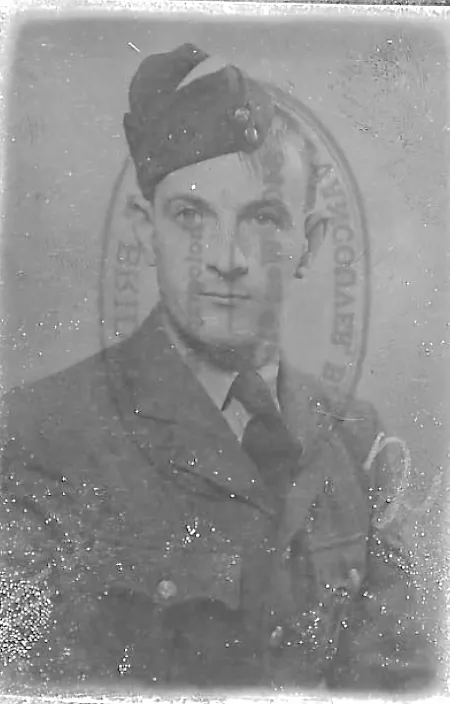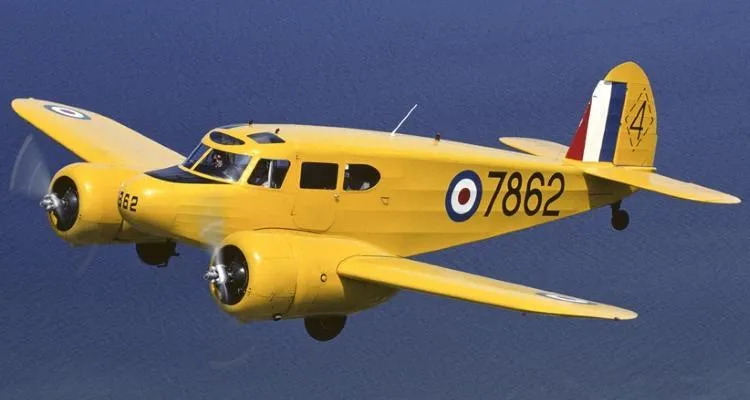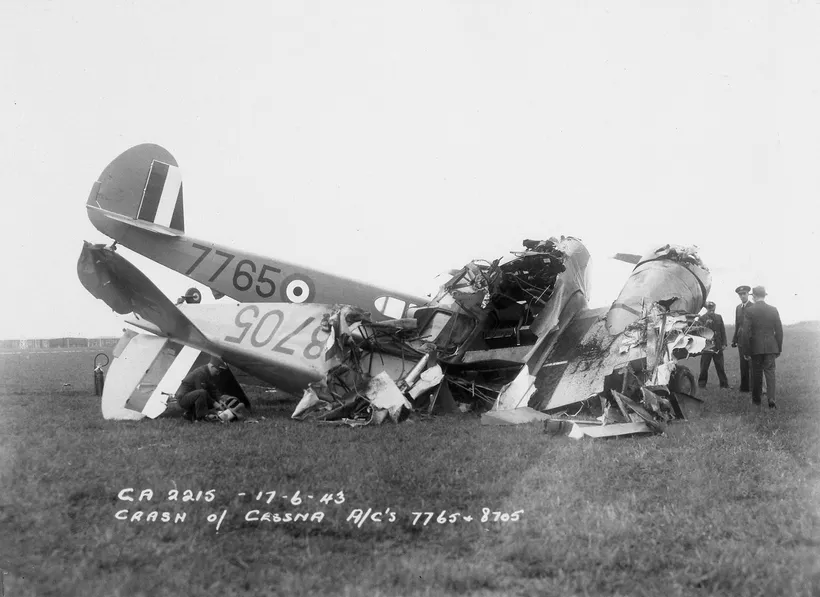McIntyre, Edward Charles (Sergeant)
Killed in Flying Accident 1944-03-21


Birth Date: 1921-January-21
Born:
Son of Dr. William H. McIntyre and Mabel McIntyre, of Mission City, British Columbia.
Home: Mission City, British Columbia
Enlistment:
Enlistment Date: Unknown
Service
RCAF
Unit
3 SFTS- Service Flying Training School
Base
Calgary, Alberta, Canada
Rank
Sergeant
Position
Corporal
Service Numbers
R/225247
Cessna Crane aircraft 7676 had been flying in formation and broke out of the formation to join the landing circuit. While in the landing circuit 7676 was in a mid-air collision with Crane 7922. The aircraft crashed at 16th. St and 42nd. Ave, S.W., Calgary. Sergeant McIntyre was killed in aircraft 7676 and Leading Aircraftman S.N. Rowell (RAAF) was killed in aircraft 7922. He was promoted posthumously to the Rank of Sergeant.
This incident involved multiple aircraft:
- Crane Mk. I Serial: 7676
- Crane Mk. I Serial: 7922
All the above aircraft in the above list are referenced in this report.
Cessna Crane

Canadian Warplane Heritage Museum
The Cessna T-50 Crane was the RCAF version of the Cessna AT-17 Bobcat, a twin-engined advanced trainer designed and made in the USA during the Second World War. It served to bridge the gap between single-engined trainers and twin-engined combat aircraft.
First flown in 1939, the American-built Cessna Crane was developed as a five-seat, light transport civilian aircraft. It was originally intended to serve only a minor role within the BCATP (an initial 180 were ordered in 1940) until the Canadian-built Avro Ansons became available in greater numbers. This was the first large order that Cessna had received for one of its products. Eventually, more than 5,400 Cranes would be produced, of which 826 saw service with the RCAF. Cessna Cranes were used primarily to teach future bomber pilots, after they had received their initial training, to fly multi-engined aircraft at Service Flying Training Schools in western Canada.
Powered by 245-horsepower Jacobs R-755-9 radial engines, Cessna Cranes featured wooden wings and tail married to a fuselage constructed of welded steel tubing. Most of the aircraft was fabric-covered. It was cheap, reliable and relatively easy to fly, with a top speed of 315 kilometres (195 miles) per hour.
The Crane provided twin-engined complexity with economy of operation and went on to become one of the most important aircraft used by the BCATP. Cranes continued to serve with the RCAF until 1947, after which many were purchased by private individuals and companies.
Nicknamed the Bamboo Bomber because of its largely wood construction, the Crane had a reputation as a stable and reliable aircraft. Although not an ideal training aircraft because of its poor single-engined performance and load-carrying capability, it performed its duties satisfactorily and helped train several thousand bomber pilots.Bomber Command Museum of Canada
3 SFTS (3 Service Flying Training School)
Graduates of the EFTS "learn-to-fly" program went on a Service Flying Training School (SFTS) for 16 weeks. For the first 8 weeks the trainee was part of an intermediate training squadron; for the next 6 weeks an advanced training squadron and for the final 2 weeks training was conducted at a Bombing & Gunnery School. The Service schools were military establishments run by the RCAF or the RAF.
There were two different types of Service Flying Training Schools. Trainees in the fighter pilot stream went to an SFTS like No. 14 Aylmer, where they trained in the North American Harvard or North American Yale. Trainees in the bomber, coastal or transport pilot stream went to an SFTS like No. 5 Brantford where they learned multi-engine technique in an Airspeed Oxford, Avro Anson or Cessna Crane.

For More Information on RCAF Station Calgary see here


 Bomber Command Museum of Canada
Bomber Command Museum of Canada
Crane 7676
Crane Mk. I 7676
First assigned to No. 4 Service Flying Training School at Saskatoon, Saskatchewan. Category C14 damage at Vanscoy relief aerodrome at 11:45 on 1 May 1941. To Prairie Airways at Moose Jaw for repairs on 9 July 1941, with 334:50 logged time. To No. 4 Training Command on 11 December 1941, delivered to No. 3 Service Flying Training School at Calgary, Alberta on 29 December 1941. Category B damage at Calgary aerodrome at 13:25 on 11 March 1942, nosed over due to heavy braking. To Prairie Airways for repairs on 13 March 1942, with 435:00 logged time. To No. 2 Training Command on 10 July 1942. To Prairie Airways, 17 June to 14 September 1943. To storage with No. 2 Training Command when completed. To No. 4 Training Command on 11 December 1943. Category A damage at Calgary on 21 March 1944, collided with Crane 7922 during landing after formation training. Sgt. E.C. McIntyre killed in this aircraft. Fuselage and empennage allocated to Prairie Airways for inspection on 24 March 1944, following this crash. Scrapped by No. 10 Repair Depot.1941-02-18 Taken on Strength No. 2 Training Command 2019-08-20
1941-May-01 Accident: 4 Service Flying Training School Loc: Vanscoy Aerodrome Names: Williams
1942-March-11 Accident: 3 Service Flying Training School Loc: Aerodrome Names: Cook | Mcewan
1943-June-04 Accident: 4 Service Flying Training School Loc: Aerodrome Names: Bergin
1943-December-05 Accident: 3 Service Flying Training School Loc: Aerodrome Names: Murphy
1944-March-21 Accident: 3 Service Flying Training School Loc: Aerodrome Names: Mcintyre | Rowell
1944-04-25 Struck off Strength Written off, reduced to spares and produce 2019-08-20
Crane 7922
Crane Mk. I 7922
To Prairie Airways for overhaul, 15 October to 24 November 1943. To storage with No. 4 Training Command when completed. Issued from storage on 6 December 1943. Category A damage at Calgary on 21 March 1944, collided with Crane 7676 during landing after formation training. Leading Aircraftman S.N. Rowell, RAAF killed in this aircraft. To No. 10 Repair Depot on 24 March 1944 for inspection. Scrapped without being repaired.1941-09-03 Taken on Strength No. 2 Training Command 2019-08-20
1942-December-09 Accident: 10 Service Flying Training School Loc: Aerodrome Names: Murray | Poole
1944-March-21 Accident: 3 Service Flying Training School Loc: Aerodrome Names: Mcintyre | Rowell
1944-04-25 Struck off Strength Struck off, reduced to spares and produce 2019-08-20
 Mission City, British Columbia
Mission City, British Columbia Canadian Virtual War Memorial
Canadian Virtual War Memorial Commonwealth War Graves Commission
Commonwealth War Graves Commission www.findagrave.com
www.findagrave.com Cessna Crane Trainer
Cessna Crane Trainer Wikipedia Crane Trainer
Wikipedia Crane Trainer Harold A Skaarup Web Page
Harold A Skaarup Web Page